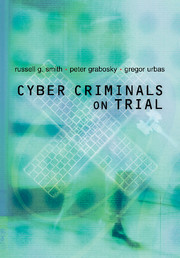Book contents
- Frontmatter
- Contents
- List of figures and tables
- Acknowledgments
- Preface
- Abbreviations
- Currency exchange rates
- Chapter One Introduction
- Chapter Two Defining and Measuring Cyber Crime
- Chapter Three The Prosecutor as Gatekeeper
- Chapter Four Cross-Border Issues
- Chapter Five Strategies of Cyber Crime Litigation
- Chapter Six The Quest for Harmonisation of Cyber Crime Laws
- Chapter Seven Judicial Punishment in Cyberspace
- Chapter Eight Sentencing Cyber Criminals
- Chapter Nine Conclusions
- References
- Appendix A Case Summaries 1972–2003
- Appendix B Selected Legislative Summaries
- Index
Chapter Five - Strategies of Cyber Crime Litigation
Published online by Cambridge University Press: 22 September 2009
- Frontmatter
- Contents
- List of figures and tables
- Acknowledgments
- Preface
- Abbreviations
- Currency exchange rates
- Chapter One Introduction
- Chapter Two Defining and Measuring Cyber Crime
- Chapter Three The Prosecutor as Gatekeeper
- Chapter Four Cross-Border Issues
- Chapter Five Strategies of Cyber Crime Litigation
- Chapter Six The Quest for Harmonisation of Cyber Crime Laws
- Chapter Seven Judicial Punishment in Cyberspace
- Chapter Eight Sentencing Cyber Criminals
- Chapter Nine Conclusions
- References
- Appendix A Case Summaries 1972–2003
- Appendix B Selected Legislative Summaries
- Index
Summary
Introduction
As we have noted, even in matters where jurisdiction is not a problem, the vast majority of cyber crimes never go to trial. In those that do, the evidence may not be overwhelmingly indicative of guilt, or there may be some basis for challenging the processes by which it was obtained. In either event, the prosecutor can usually expect a vigorous defence. This chapter discusses some of the issues that prosecutors may have to confront, either during an investigation, on the steps of the courthouse, in the course of a trial, or in the event of an appeal.
We have seen that the involvement of the prosecutor in the planning and execution of an investigation will vary from country to country. The nature of cyber crime is such that prosecutors are more likely than not to become involved at an earlier stage. In the common law world, this is most pronounced in the United States, where, as we shall see, there is ample constitutional basis for challenging the admissibility of evidence.
Possible defence strategies that might be anticipated or contested by the prosecution may take a variety of general forms. The issue of jurisdiction was addressed above in Chapter Four. Depending on the nature of the alleged offence and the circumstances of the investigation, an accused may claim:
that he or she was not the person who did the act;
that the act or acts in question were not intentional;
[…]
- Type
- Chapter
- Information
- Cyber Criminals on Trial , pp. 61 - 85Publisher: Cambridge University PressPrint publication year: 2004



